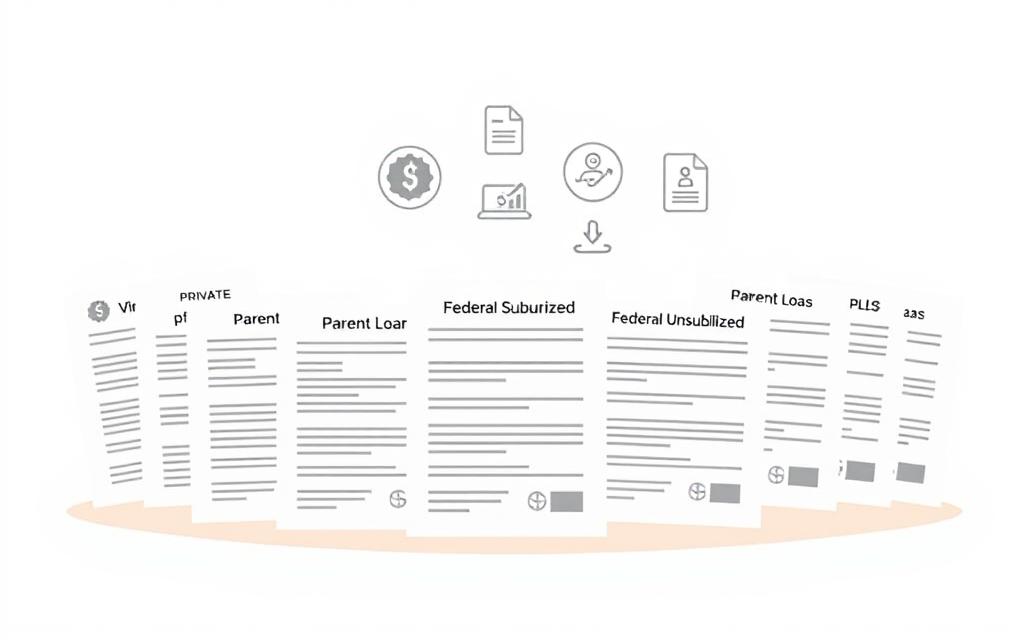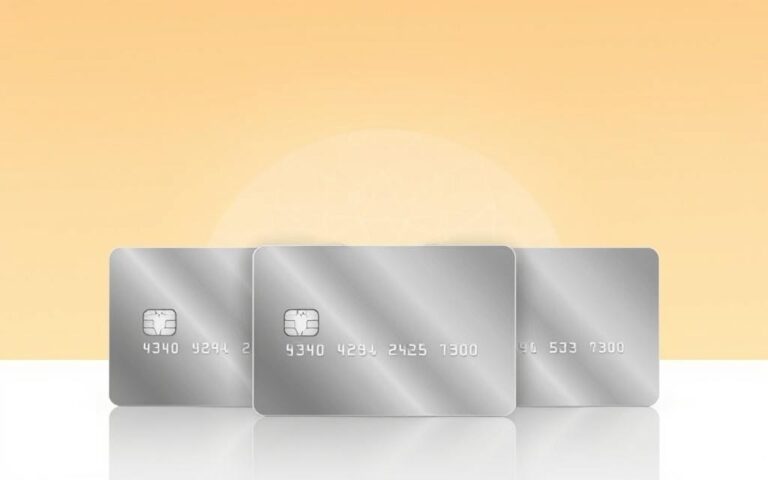Advertisement
The weight of educational debt is heavy for many Americans. With over $1.7 trillion in outstanding student loans, it’s clear that finding good repayment plans is crucial.
Knowing the best ways to repay student loans can save you a lot of money. It can also reduce your financial stress. A smart repayment strategy can really help.
This article will dive into different student loan repayment strategies. We’ll look at ways to manage your debt and gain financial freedom. By the end, you’ll know how to make smart choices about your loan repayment.
Understanding Your Student Loan Types
Student loan repayment starts with knowing your loan types. This includes federal, private, subsidized, or unsubsidized loans. It’s important because it shapes your repayment options and strategies.
There are key differences between loan types. The main difference is between federally backed loans and private loans. Federal loans can also be subsidized or unsubsidized, each with its own rules and benefits.

Federal Loans vs. Private Loans
Federal loans are backed by the government. They offer lower interest rates and flexible repayment options. These loans are often more borrower-friendly, with options like income-driven repayment plans and loan forgiveness programs.
Private loans come from banks, credit unions, and other lenders. They may have variable interest rates and less flexible repayment terms. Yet, private loans can be a good choice for students who’ve used up their federal loan eligibility or need more funding.
- Federal Loans: Generally have lower interest rates and more repayment options.
- Private Loans: May offer higher loan amounts but often with less favorable terms.
Subsidized vs. Unsubsidized Loans
Within federal loans, there are subsidized and unsubsidized loans. Subsidized loans are need-based. The government pays the interest while you’re in school, during deferment, and during grace periods. This can greatly reduce what you owe over time.
Unsubsidized loans, on the other hand, start accruing interest right away. You must pay all the interest on unsubsidized loans. This can increase the total cost of the loan.
- Subsidized Loans: Government pays interest while you’re in school.
- Unsubsidized Loans: You’re responsible for all interest accrued.
Understanding these differences is crucial for managing student loan payments effectively. Knowing if you have federal or private loans, and if they’re subsidized or unsubsidized, helps you make better repayment decisions.
The Importance of a Repayment Plan
A good repayment plan can save you thousands of dollars in interest. It’s key to manage your student loan debt well. You need to know your financial duties and have a smart repayment strategy.
Why Have a Strategy?
Having a student loan repayment strategy is vital. It helps you make smart choices about your debt. Without a plan, you might pay more in interest or miss payments, harming your credit score.
A solid strategy means knowing your loan types, like subsidized and unsubsidized loans. It also means picking the best way to pay off your debt based on your finances.
How to Assess Your Financial Situation
To make a realistic repayment plan, you must understand your finances. First, calculate your total debt, including principal and interest rates for each loan.
Then, look at your income and expenses to see how much you can pay each month. Use a budgeting tool or spreadsheet to track your money. This helps you find ways to save more for your debt.
Knowing your finances and having a clear plan helps you tackle your debt. You can reduce your student loan interest and pay off your debt faster.
Popular Repayment Plans Explained
Understanding student loan repayment plans is key. The right plan can make managing your debt easier.
Standard Repayment Plan
The Standard Repayment Plan is the default for many federal loans. It has fixed monthly payments for 10 years. It’s good for those who can afford the payments and want to pay off loans fast.
Key Benefits: Pay off loans quickly, fixed monthly payments.
Graduated Repayment Plan
The Graduated Repayment Plan starts with lower payments that grow every two years. It’s best for those who expect their income to rise.
Example: Payments start low and increase as your salary grows.
Extended Repayment Plan
The Extended Repayment Plan stretches repayment up to 25 years, based on the loan amount. It lowers monthly payments but may mean paying more interest over time.
| Repayment Plan | Monthly Payment | Repayment Period |
|---|---|---|
| Standard | Fixed | Up to 10 years |
| Graduated | Increasing | Up to 10 years |
| Extended | Fixed or Graduated | Up to 25 years |
Knowing these repayment plans is vital for best ways to repay student loans and managing student loan payments. The right plan can simplify your finances and help you become debt-free.
Income-Driven Repayment (IDR) Plans
For those with high debt, IDR plans are a big help. They adjust payments to match what you can afford. This is a big relief for those struggling to pay their loans.
What Are IDR Plans?
IDR plans make payments easier by linking them to your income. There are different types, like Income-Based Repayment (IBR) and Pay As You Earn (PAYE). Each has its own rules and benefits.
Eligibility Requirements
To get an IDR plan, you need a certain federal loan and must be struggling financially. The rules differ by plan. For example, IBR and PAYE need a financial hardship, but REPAYE doesn’t.
Key eligibility factors include:
- Type of federal student loan
- Income level
- Family size
Benefits of IDR Plans
IDR plans have many perks. They lower your monthly payments and might forgive your loan after a while. This helps you avoid falling behind on payments.
Some of the key advantages of IDR plans include:
- Lower monthly payments: Payments are based on income, making them more affordable.
- Potential for loan forgiveness: After 20 or 25 years of qualifying payments, remaining balances may be forgiven.
- Reducing student loan interest: Lower monthly payments can help reduce the overall interest paid on the loan.
Understanding IDR plans can help you manage your student loan debt. It’s a step towards financial stability.
Refinancing Your Student Loans
Refinancing student loans can make debt more manageable. It involves swapping old loans for a new one. This new loan often has a lower interest rate or better repayment terms.
Advantages of Refinancing
Refinancing can save a lot of money, mainly for those with high-interest loans. Getting a lower interest rate means smaller monthly payments. It also means paying less over the loan’s life. Plus, it can make managing your finances easier by combining multiple loans into one.
Key benefits include:
- Lower monthly payments
- Reduced total interest paid
- Simplified financial management
Potential Risks to Consider
Refinancing has its downsides. You might lose federal loan benefits like income-driven plans or forgiveness programs. Also, even with a lower rate, a longer repayment period can mean more interest paid overall.
When to Refinance
Deciding to refinance depends on your financial situation. Those with high-interest loans, stable income, and good credit are often good candidates. It’s also a good choice if you want to switch to a fixed rate from a variable one. But, if you value federal loan protections, think carefully before refinancing.
Tips for paying off student debt: Always check your finances and credit score before refinancing. Also, compare offers from different lenders to find the best deal.
How to Pay Off Loans Faster
Paying off student loans quickly can save a lot of money in interest. By using smart repayment strategies, people can handle their debt better. This helps them reach financial stability sooner.
Making Extra Payments
Making extra payments is one of the best ways to repay student loans. Paying more than the minimum each month cuts down the principal. This means you pay less interest over time.
Before adding extra payments, check with your loan servicer. Make sure the extra money goes to the principal. Some lenders have rules about extra payments, so it’s important to know these.
The Avalanche vs. Snowball Method
There are two main ways to manage student loan payments: the avalanche and snowball methods. The avalanche method focuses on paying off loans with the highest interest rates first. This saves the most money in interest over time.
The snowball method starts with the smallest balances first. This gives a quick win as you pay off smaller debts. It’s a psychological boost.
Both methods have their benefits. The right choice depends on your financial situation and what you prefer. Think about your goals and pick the method that fits you best.
By learning the best ways to repay student loans and picking a good strategy, you can manage your payments well. This helps you reach financial freedom faster.
Utilizing Forgiveness Programs
Understanding forgiveness programs is key for those wanting to cut their debt. Many don’t know about the options they have, missing out on big savings.
Forgiveness programs help those in certain jobs, like public service and education. They can greatly reduce or wipe out student loan debt for those who qualify.
Public Service Loan Forgiveness
Public Service Loan Forgiveness (PSLF) is for those in public service jobs. This includes government, non-profit, and some other organizations. To qualify, you need a Direct Loan and a specific repayment plan.
- Make 120 qualifying payments
- Work full-time for a qualifying employer
- Be enrolled in a qualifying repayment plan
Once you meet these conditions, you might get your loan balance forgiven. Make sure your employer is eligible and you’re on the right plan.
Teacher Loan Forgiveness
Teacher Loan Forgiveness is for teachers in low-income schools or in needed subjects. Teachers must teach full-time for five years to qualify.
Teachers can get up to $17,500 in loan forgiveness on Direct Loans or FFEL. The forgiveness amount depends on the subject and the school’s income.
To get the most from these programs, know the rules and how to apply. Check each program’s requirements and plan to meet them. This way, you can reduce your student loan debt.
Using these forgiveness programs can greatly lower your student loan debt. It’s a great option for those in public service and education, helping them achieve financial freedom.
The Role of Budgeting in Repayment
A realistic budget is key to a good student loan repayment plan. It helps you understand your finances and manage your debt better.
Creating a Realistic Budget
Start by looking at your income and expenses to make a budget. Find ways to save money by cutting back on things you don’t need. Use the 50/30/20 rule as a guide: 50% for needs, 30% for wants, and 20% for savings and debt.
Prioritizing Needs Over Wants is important for good money management. Know the difference between what you need and what you want, and adjust your spending.
Tracking Expenses and Income
It’s important to track your spending and income. Use apps or spreadsheets to keep an eye on your money. This helps you see where your money goes and make better choices.
Regularly reviewing your budget helps you stay on track with your repayment goals. It’s a way to adjust to changes in your finances.
Adding budgeting to your student loan plan can reduce stress and help you pay off debt faster. The secret is to be consistent and flexible with your budget.
Resources for Loan Repayment Assistance
Borrowers can find many tools and programs to help with student loan repayment. These resources make it easier to handle loan repayment.
Government Programs and Websites
The government has several programs and websites to aid borrowers. The Federal Student Aid website is a key resource. It offers information on loan forgiveness, income-driven plans, and more.
Key Government Resources:
- National Student Loan Data System (NSLDS)
- StudentLoans.gov
- CollegeScoreboard.ed.gov
| Resource | Description | Benefit |
|---|---|---|
| NSLDS | Database of federal student loans | Track loan status and history |
| StudentLoans.gov | Portal for managing federal loans | Consolidate loans and apply for forgiveness |
| CollegeScoreboard.ed.gov | College comparison tool | Make informed decisions about college costs |
Nonprofit Organizations Offering Help
Nonprofit groups also help with student loan repayment. They offer counseling, financial aid, and advocacy for borrowers.
Notable Nonprofit Organizations:
- The Institute for Financial Literacy
- National Foundation for Credit Counseling (NFCC)
- Student Loan Borrower Protection
Using these resources, borrowers can handle loan repayment better. They can make smart choices about their financial future.
Adjusting Your Strategy Over Time
As your financial situation changes, you might need to adjust your student loan repayment plan. Life events like a job change, marriage, or having children can affect your income and expenses. This makes it important to reevaluate your plan.
Reassessing Your Financial Situation
It’s good to regularly review your budget and loan repayment progress. Using tips for paying off student debt can help. This includes making extra payments or consolidating loans to optimize your plan.
Seeking Professional Guidance
If managing your debt is tough, consider getting advice from a financial advisor. They can help you find the best ways to repay your loans. They’ll create a plan that fits your needs.
By staying proactive and adjusting your strategy as needed, you can manage your student loan debt well. This will help you achieve financial stability.



